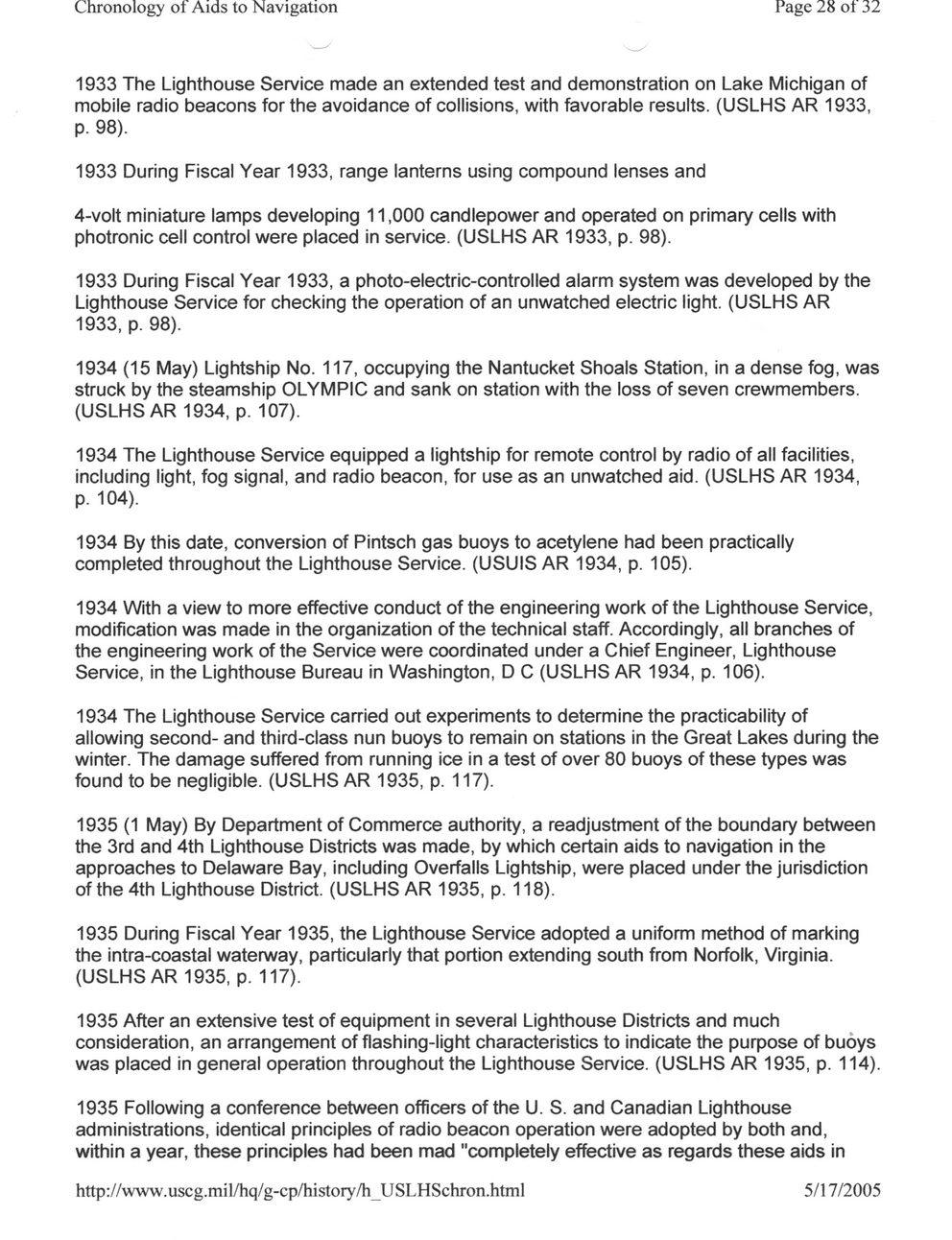This text was obtained via automated optical character recognition.
It has not been edited and may therefore contain several errors.
Chronology of Aids to Navigation Page 28 of 32 1933 The Lighthouse Service made an extended test and demonstration on Lake Michigan of mobile radio beacons for the avoidance of collisions, with favorable results. (USLHS AR 1933, p. 98). 1933 During Fiscal Year 1933, range lanterns using compound lenses and 4-volt miniature lamps developing 11,000 candlepower and operated on primary cells with photronic cell control were placed in service. (USLHS AR 1933, p. 98). 1933 During Fiscal Year 1933, a photo-electric-controlled alarm system was developed by the Lighthouse Service for checking the operation of an unwatched electric light. (USLHS AR 1933, p. 98). 1934 (15 May) Lightship No. 117, occupying the Nantucket Shoals Station, in a dense fog, was struck by the steamship OLYMPIC and sank on station with the loss of seven crewmembers. (USLHS AR 1934, p. 107). 1934 The Lighthouse Service equipped a lightship for remote control by radio of all facilities, including light, fog signal, and radio beacon, for use as an unwatched aid. (USLHS AR 1934, p. 104). 1934 By this date, conversion of Pintsch gas buoys to acetylene had been practically completed throughout the Lighthouse Service. (USUIS AR 1934, p. 105). 1934 With a view to more effective conduct of the engineering work of the Lighthouse Service, modification was made in the organization of the technical staff. Accordingly, all branches of the engineering work of the Service were coordinated under a Chief Engineer, Lighthouse Service, in the Lighthouse Bureau in Washington, D C (USLHS AR 1934, p. 106). 1934 The Lighthouse Service carried out experiments to determine the practicability of allowing second- and third-class nun buoys to remain on stations in the Great Lakes during the winter. The damage suffered from running ice in a test of over 80 buoys of these types was found to be negligible. (USLHS AR 1935, p. 117). 1935 (1 May) By Department of Commerce authority, a readjustment of the boundary between the 3rd and 4th Lighthouse Districts was made, by which certain aids to navigation in the approaches to Delaware Bay, including Overfalls Lightship, were placed under the jurisdiction of the 4th Lighthouse District. (USLHS AR 1935, p. 118). 1935 During Fiscal Year 1935, the Lighthouse Service adopted a uniform method of marking the intra-coastal waterway, particularly that portion extending south from Norfolk, Virginia. (USLHS AR 1935, p. 117). 1935 After an extensive test of equipment in several Lighthouse Districts and much consideration, an arrangement of flashing-light characteristics to indicate the purpose of buoys was placed in general operation throughout the Lighthouse Service. (USLHS AR 1935, p. 114). 1935 Following a conference between officers of the U. S. and Canadian Lighthouse administrations, identical principles of radio beacon operation were adopted by both and, within a year, these principles had been mad "completely effective as regards these aids in http://www.uscg.mil/hq/g-cp/history/h_USLHSchron.html 5/17/2005

Lighthouses Chronology-of-Aids-to-Navigation-(28)